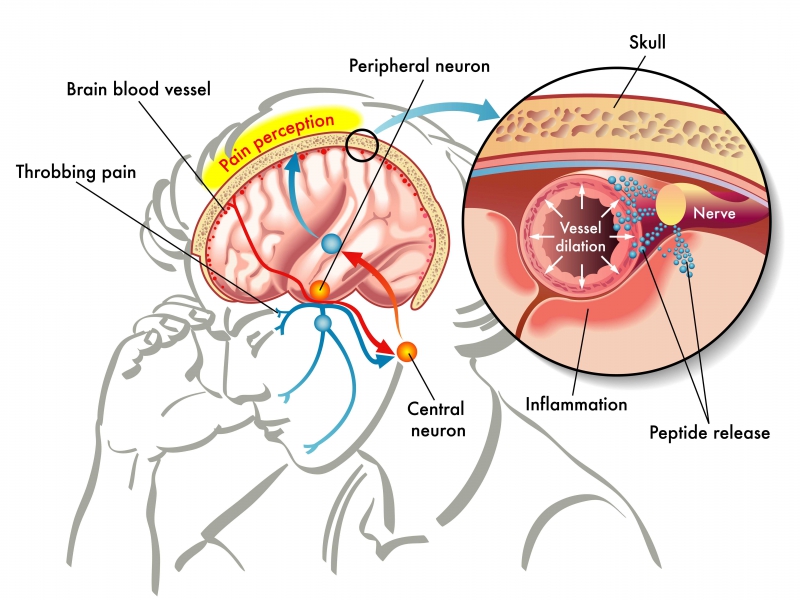Myth № 1: Migraine is an elite’s attribute
There is a belief that migraine is a disease of geniuses and extremely smart people. Many famous people as Julius Caesar, Karl Marks, Alfred Nobel, Richard Wagner and others, the list is much longer, suffered from migraine. It might have been a reason of a myth that this disease is payment for talent. However, it is not true. About 10% of population suffer from migraine, and many famous people are just part of these 10%.
Myth № 2: Migraine is a young disease
The lack of research findings related to migraine doesn’t mean that this disease appeared recently. In 3000 BC an unknown Sumerian poet described a type of headache provoking blindness. Hippocrates was the first physician who found out and wrote about it. He mentioned that prior to the pain, the patient can experience visual disturbances, and vomit during the stroke. In 2nd century, physician Galen called this "hemicrania," which is translated as "half of a head," as most people with migraine feel pain in one part of their heads. Later, doctors noticed that the focus of the disease is in the temporal or occipital regions. They’ve also detected that before a patient starts feeling the headache, he can feel faint, have visual distortions like seeing fog or flecks, auditory hallucinations and even the inability to think clearly. During the strokes, patients can get afraid of light, loud noises, flavors, moving objects and even when someone touches him.

The Middle Ages didn’t bring any new information about migraine. In 17th century, a Swiss doctor whose second name was Wepfer, suggested that migraine is related to cerebral vascular distention. Back then, scientists put forward a theory that this disease is hereditary. In the 19th century, researchers published several works on migraine giving its clinical description and also tried to find a treatment. Yet, they couldn’t reach a consensus on the reasons of pains and symptoms.
Myth № 3: Migraine is just a headache
Migraine is vascular and at the same time neurological disease, which induces different biochemical processes. It is impossible to explain its attacks with a phrase "I have a headache."
There are two types of headaches: primary and secondary. A secondary headache is a symptom of such diseases as cervical osteochondrosis, meningitis, cold-related diseases, cerebral concussion, brain traumas, etc. Primary pains are those that are considered as diseases themselves. Migraine is a primary one.
Migraine is not a joke. Those who have it are more prone to committing suicide than those who don’t suffer from it. American researchers from Michigan State University made the following experiment: for two years they’ve observed two groups of people — those with headaches and those without them. It turned out that about 10% of people from the first groups tried to commit suicide, and 1% only from second tried to do that. However, researchers didn’t find the reason behind these numbers, as if could be either chemical processes caused by pain, depressions, or something else.

Migraine’s stages
Some say that migraine strokes can be provoked by different factors when every patient has his or her own. They are called triggers. Usually, people avoid them to save themselves from the pain. Those can be staying in the sunshine or high temperature, some food, scents or even colors. However, not everyone has specific triggers.
The disease has four stages. The first one is prodrome, which is an early symptom. A patient can become bad-tempered, sick, or get hungry. The next stage is aura. One third of patients have it — they see unusual shapes, flashes of light or blur. Others experience auditory and olfactory hallucinations, or numbness.
The most severe stage is strokes, when one feels pain for from several hours to 2−3 days. One feels pain in left or right part of head only, but sometimes it captures the whole head. The pain is usually pulsing or bursting, and becomes stronger because of physical activities. Often, vomiting and nausea appear, which sometimes ease the pain.
The last stage is postdrome. Patients feel much better but fatigue doesn’t leave them. it seems that the pain is ready to come back, as an attack can go off and appear again during several days.
The background of migraine
The first stage of the disease provokes cerebral vessel constriction — it means that vessels are susceptible to deformations. It causes ischemia, which is a restriction in blood supply that leads to a shortage of oxygen necessary for one’s nervous system. This affects working efficiency and memory activity.
The blood surplus pushes vascular walls, broadening them (bursting pain). It leads to micro inflammations that affect nerve receptors. This process is considered to be the main reason of the pain. At the same time, one faces a decrease of the vascular walls' tone, so they start pulsing. That is why patients feel the so-called pulsing pain. Then, tissues surrounding the walls become swollen. This induces the dull and continuing ache.
Most people suffering from migraine experience pains only in one side of the head, but sometimes it can move to another. According to ITMO’s researchers, it can be explained by abnormal blood supply peculiar to people with migraine [Read more about this study here -Ed.].

Myth № 4: Migraine has been studied well
Some say that migraine, as any other type of headache, is a neurological disease. On one hand, it is correct, but on other, migraine is a result of several processes that are not related to neural system. Various biochemical processes are among the reasons.
Biochemical mechanisms behind migraine have not been studied sufficiently, but it’s known that they cause disorders of metabolic activity of thrombotonin (serotonin), catecholamine and histamine.
There is a theory that migraine is caused by the inborn disorder of hypothalamus, which is responsible for metabolism, body temperature, interaction of neural and endocrine system, and thalamus, which controls sensing functions. This disorder reduces the level of serotonin, which. The lack of this compound activates thrombocytes that are rich in serotonin. The right hemisphere has more thrombocytes, which is why people suffering from migraine feel pain in the right side of the head more frequently.
There is a popular idea that migraine is a cardiovascular disease, and vascular distention and constriction are not aftereffects, but the main symptoms of the disease. Some scientists also think that there is genetic disposition to migraine. According to an article published in Nature Genetics, people with migraine have dozens of specific genes, more than a half of which demonstrate predisposition to CVD.
All patients have different symptoms — the characteristics and duration of the pains are different. This makes studying of migraine very challenging. That is why it is scarcely possible to say that migraine is well studied.

Myth № 5: migraine prevention and treatment
Some physicians recommend to sleep well and avoid sleeping more than it is necessary, eat well, stop eating oranges and chocolates, reduce alcohol consumption, smoke less as well as do sports and spend more time outside. First of all, such advice is too general. Is it possible to follow all these rules during the whole life? This makes us believe that migraine prevention and treatment require medications.
Currently, there are several types of medications for preventing migraine. The first one is serotonin inhibitors; as mentioned above, dramatic increase and then reduction of serotonin can cause migraine. Another medication is antidepressants. There are also hormone medications and beta-blockers that help treat it. The latest ones are used for treatment of cardiovascular diseases. They "block" hormones and agents like adrenaline, which increases heart rate.
How to fight migraine attacks? Sometimes paracetamol, aspirin and caffeine can be effective. Such painkillers as, for instance, ibuprofen also work. If these medications are useless, physician prescribe triptane. It is used to "block" migraine, i.e. kill the pain quickly.
Currently, scientists from all over the world try to find a medication which would affect genes provoking migraine. Unfortunately, there are still no breakthroughs in this field.
There are too many facts about migraine to be known, but we already know the main ones: migraine is a disease, which can provoke such serious aftereffects as strokes, epilepsy attacks and chronic headaches that can continue for over 15 days per month. That is why everybody who suffers from migraine has to visit a doctor!

